Deakin University HSE201 Exercise Physiology Lab 3: Metabolism Report
VerifiedAdded on 2022/09/18
|16
|3099
|50
Practical Assignment
AI Summary
This practical assignment delves into the intricacies of exercise physiology and metabolism, analyzing data from two laboratory sessions. The assignment begins with recording and analyzing data related to environmental conditions, participant characteristics, and laboratory values, including oxygen consumption, respiratory exchange ratio (RER), and energy expenditure during rest, exercise, and recovery. Calculations are performed to determine energy expenditure, gross and net efficiency, and substrate oxidation rates. The report involves the creation and interpretation of graphs illustrating oxygen consumption over time and substrate contribution during varying exercise intensities. Key concepts such as oxygen deficit, ATP production, and the influence of exercise intensity on fuel utilization are thoroughly examined. The assignment also includes a case study where metabolic determinants of exercise performance are explored, including the shifts in fuel use during prolonged exercise and the potential benefits of carbohydrate feeding. The student reflects on feedback from previous reports to improve the quality of their answers and analysis. This comprehensive report offers a detailed examination of the metabolic responses to exercise.
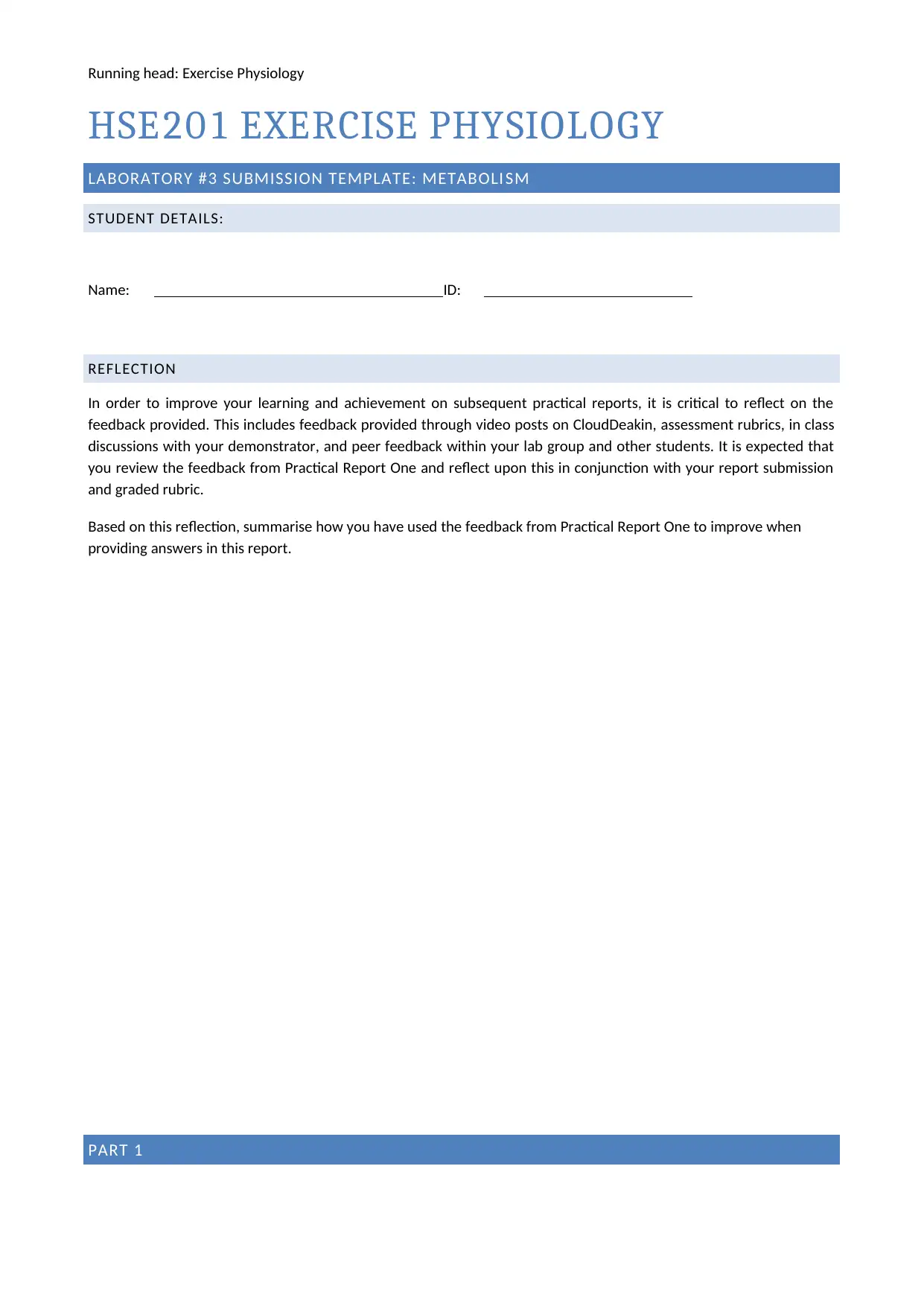
Running head: Exercise Physiology
HSE201 EXERCISE PHYSIOLOGY
LABORATORY #3 SUBMISSION TEMPLATE: METABOLI SM
STUDENT DETAILS:
Name: ID:
REFLECTION
In order to improve your learning and achievement on subsequent practical reports, it is critical to reflect on the
feedback provided. This includes feedback provided through video posts on CloudDeakin, assessment rubrics, in class
discussions with your demonstrator, and peer feedback within your lab group and other students. It is expected that
you review the feedback from Practical Report One and reflect upon this in conjunction with your report submission
and graded rubric.
Based on this reflection, summarise how you have used the feedback from Practical Report One to improve when
providing answers in this report.
PART 1
HSE201 EXERCISE PHYSIOLOGY
LABORATORY #3 SUBMISSION TEMPLATE: METABOLI SM
STUDENT DETAILS:
Name: ID:
REFLECTION
In order to improve your learning and achievement on subsequent practical reports, it is critical to reflect on the
feedback provided. This includes feedback provided through video posts on CloudDeakin, assessment rubrics, in class
discussions with your demonstrator, and peer feedback within your lab group and other students. It is expected that
you review the feedback from Practical Report One and reflect upon this in conjunction with your report submission
and graded rubric.
Based on this reflection, summarise how you have used the feedback from Practical Report One to improve when
providing answers in this report.
PART 1
Paraphrase This Document
Need a fresh take? Get an instant paraphrase of this document with our AI Paraphraser

Exercise Physiology
DATA RECORDING AND ANALYSIS
TASK 1: RECORD THE RELEVANT DATA IN THE TABLE
Environmental Conditions and Participant Characteristics
Laboratory Values
Barometric/Atmospheric Pressure (mmHg) 768
Room Temperature (°C) 19.2
Relative Humidity (%) 56.8
Sex Male
Age (years) 22
Height (m) 176.3
Body Mass (kg) 73.5
BMI (kg/m2) 23.6
BMI Classification Normal weight
2
DATA RECORDING AND ANALYSIS
TASK 1: RECORD THE RELEVANT DATA IN THE TABLE
Environmental Conditions and Participant Characteristics
Laboratory Values
Barometric/Atmospheric Pressure (mmHg) 768
Room Temperature (°C) 19.2
Relative Humidity (%) 56.8
Sex Male
Age (years) 22
Height (m) 176.3
Body Mass (kg) 73.5
BMI (kg/m2) 23.6
BMI Classification Normal weight
2

Exercise Physiology
Energy Expenditure During Rest, Exercise and Recovery
PERI
OD TIME (min) ˙V O2 (l.min-1) RER ˙VE (l.min-1)
Rest ----- 0.27 0.947 5.79
Exerc
ise
0.5 0.44 0.937 14.12
1.0 0.93 0.779 19.62
1.5 1.30 0.747 23.20
2.0 1.40 0.799 26.27
2.5 1.43 0.867 29.07
3.0 1.41 0.942 31.13
3.5 1.55 0.924 33.40
4.0 1.26 0.960 29.35
4.5 1.41 0.890 29.61
5.0 1.49 0.933 33.34
Average Steady state
Reco
very
0.5 1.38 0.902 29.51
1.0 1.27 0.87 26.10
1.5 0.77 0.96 18.91
2.0 0.52 1.02 14.14
2.5 0.43 1.05 12.86
3.0 0.40 1.02 11.98
3.5 0.20 1.04 6.73
4.0 0.26 0.97 8.77
4.5 0.33 0.85 9.54
5.0 0.26 0.84 7.07
3
Energy Expenditure During Rest, Exercise and Recovery
PERI
OD TIME (min) ˙V O2 (l.min-1) RER ˙VE (l.min-1)
Rest ----- 0.27 0.947 5.79
Exerc
ise
0.5 0.44 0.937 14.12
1.0 0.93 0.779 19.62
1.5 1.30 0.747 23.20
2.0 1.40 0.799 26.27
2.5 1.43 0.867 29.07
3.0 1.41 0.942 31.13
3.5 1.55 0.924 33.40
4.0 1.26 0.960 29.35
4.5 1.41 0.890 29.61
5.0 1.49 0.933 33.34
Average Steady state
Reco
very
0.5 1.38 0.902 29.51
1.0 1.27 0.87 26.10
1.5 0.77 0.96 18.91
2.0 0.52 1.02 14.14
2.5 0.43 1.05 12.86
3.0 0.40 1.02 11.98
3.5 0.20 1.04 6.73
4.0 0.26 0.97 8.77
4.5 0.33 0.85 9.54
5.0 0.26 0.84 7.07
3
⊘ This is a preview!⊘
Do you want full access?
Subscribe today to unlock all pages.

Trusted by 1+ million students worldwide
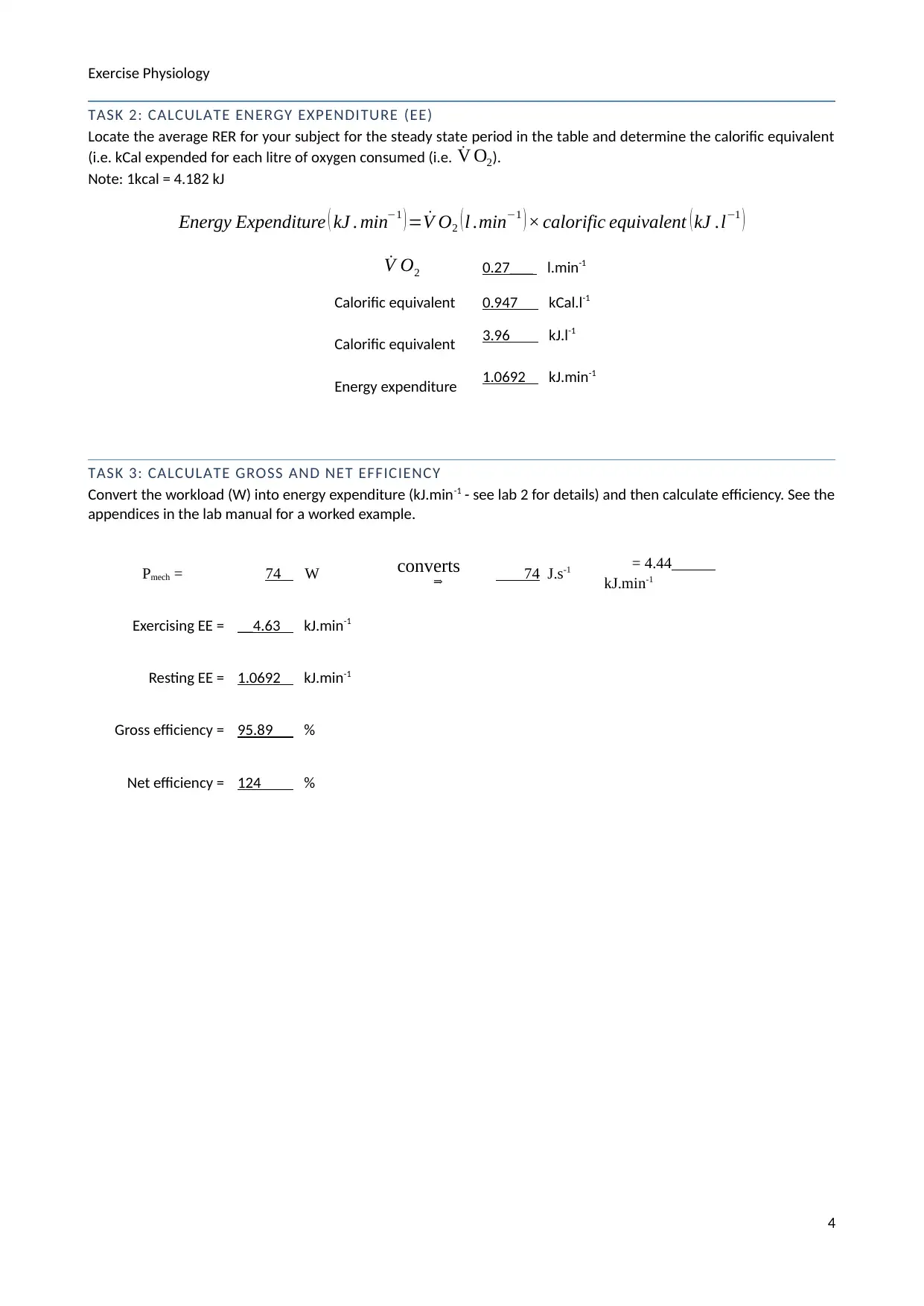
Exercise Physiology
TASK 2: CALCULATE ENERGY EXPENDITURE (EE)
Locate the average RER for your subject for the steady state period in the table and determine the calorific equivalent
(i.e. kCal expended for each litre of oxygen consumed (i.e. ˙V O2).
Note: 1kcal = 4.182 kJ
Energy Expenditure ( kJ . min−1 ) = ˙V O2 ( l .min−1 ) × calorific equivalent ( kJ .l−1 )
˙V O2 0.27___ l.min-1
Calorific equivalent 0.947 kCal.l-1
Calorific equivalent 3.96 kJ.l-1
Energy expenditure 1.0692 kJ.min-1
TASK 3: CALCULATE GROSS AND NET EFFICIENCY
Convert the workload (W) into energy expenditure (kJ.min-1 - see lab 2 for details) and then calculate efficiency. See the
appendices in the lab manual for a worked example.
Pmech = 74 W converts to
⇒ 74 J.s-1 = 4.44
kJ.min-1
Exercising EE = __4.63 kJ.min-1
Resting EE = 1.0692 kJ.min-1
Gross efficiency = 95.89 %
Net efficiency = 124 %
4
TASK 2: CALCULATE ENERGY EXPENDITURE (EE)
Locate the average RER for your subject for the steady state period in the table and determine the calorific equivalent
(i.e. kCal expended for each litre of oxygen consumed (i.e. ˙V O2).
Note: 1kcal = 4.182 kJ
Energy Expenditure ( kJ . min−1 ) = ˙V O2 ( l .min−1 ) × calorific equivalent ( kJ .l−1 )
˙V O2 0.27___ l.min-1
Calorific equivalent 0.947 kCal.l-1
Calorific equivalent 3.96 kJ.l-1
Energy expenditure 1.0692 kJ.min-1
TASK 3: CALCULATE GROSS AND NET EFFICIENCY
Convert the workload (W) into energy expenditure (kJ.min-1 - see lab 2 for details) and then calculate efficiency. See the
appendices in the lab manual for a worked example.
Pmech = 74 W converts to
⇒ 74 J.s-1 = 4.44
kJ.min-1
Exercising EE = __4.63 kJ.min-1
Resting EE = 1.0692 kJ.min-1
Gross efficiency = 95.89 %
Net efficiency = 124 %
4
Paraphrase This Document
Need a fresh take? Get an instant paraphrase of this document with our AI Paraphraser
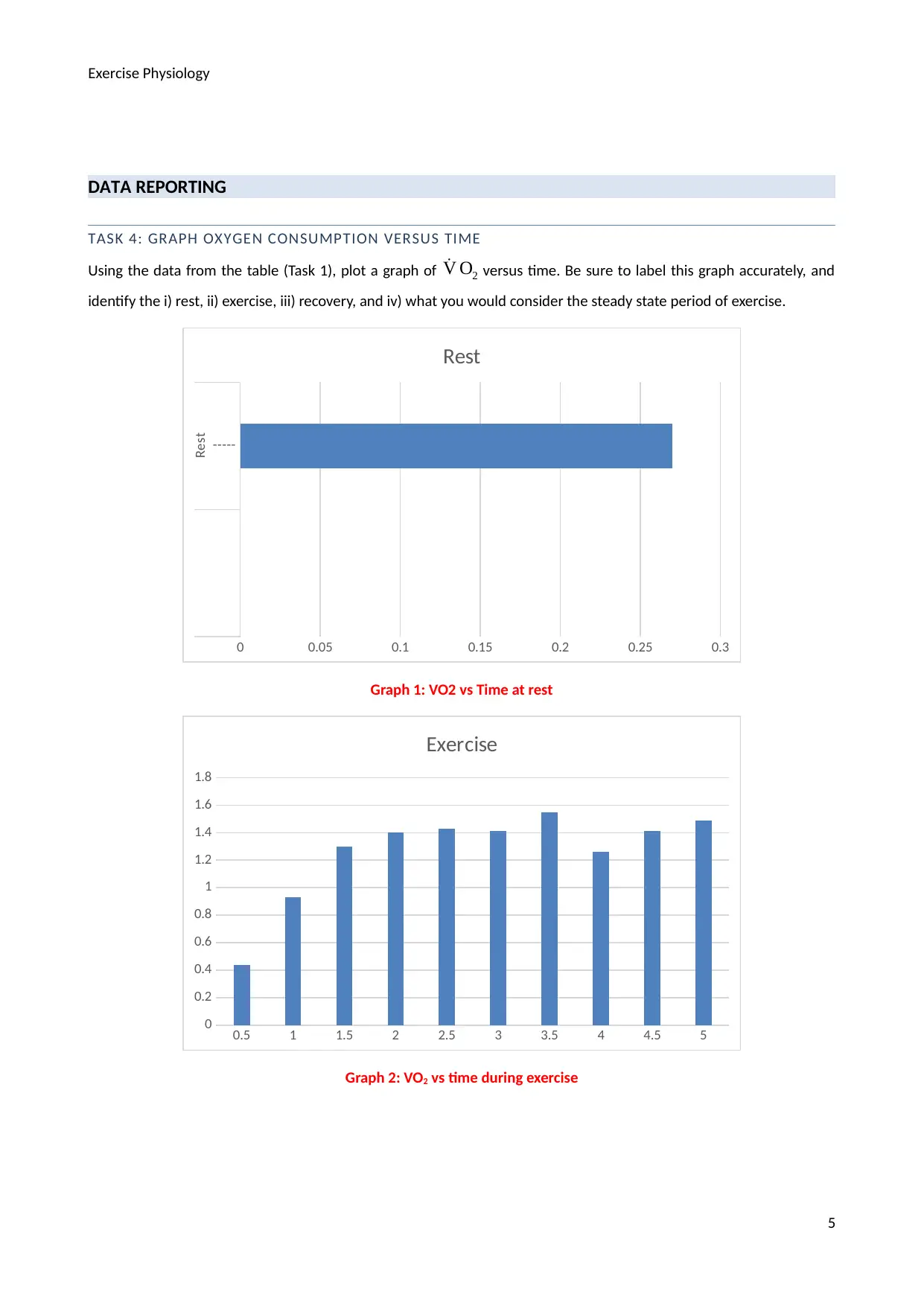
Exercise Physiology
DATA REPORTING
TASK 4: GRAPH OXYGEN CONSUMPTION VERSUS TIME
Using the data from the table (Task 1), plot a graph of ˙V O2 versus time. Be sure to label this graph accurately, and
identify the i) rest, ii) exercise, iii) recovery, and iv) what you would consider the steady state period of exercise.
-----
Rest
0 0.05 0.1 0.15 0.2 0.25 0.3
Rest
Graph 1: VO2 vs Time at rest
0.5 1 1.5 2 2.5 3 3.5 4 4.5 5
0
0.2
0.4
0.6
0.8
1
1.2
1.4
1.6
1.8
Exercise
Graph 2: VO2 vs time during exercise
5
DATA REPORTING
TASK 4: GRAPH OXYGEN CONSUMPTION VERSUS TIME
Using the data from the table (Task 1), plot a graph of ˙V O2 versus time. Be sure to label this graph accurately, and
identify the i) rest, ii) exercise, iii) recovery, and iv) what you would consider the steady state period of exercise.
-----
Rest
0 0.05 0.1 0.15 0.2 0.25 0.3
Rest
Graph 1: VO2 vs Time at rest
0.5 1 1.5 2 2.5 3 3.5 4 4.5 5
0
0.2
0.4
0.6
0.8
1
1.2
1.4
1.6
1.8
Exercise
Graph 2: VO2 vs time during exercise
5
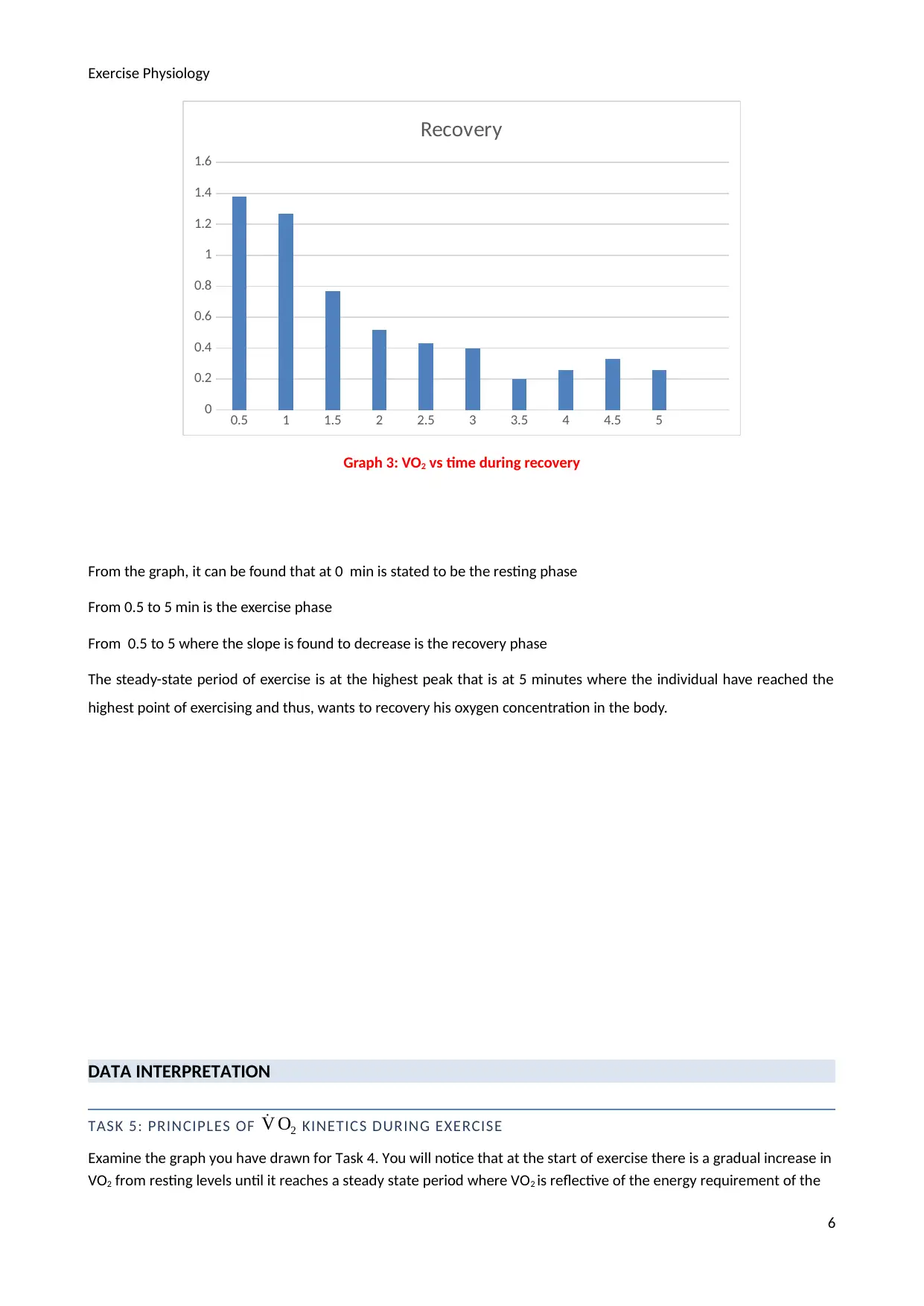
Exercise Physiology
0.5 1 1.5 2 2.5 3 3.5 4 4.5 5
0
0.2
0.4
0.6
0.8
1
1.2
1.4
1.6
Recovery
Graph 3: VO2 vs time during recovery
From the graph, it can be found that at 0 min is stated to be the resting phase
From 0.5 to 5 min is the exercise phase
From 0.5 to 5 where the slope is found to decrease is the recovery phase
The steady-state period of exercise is at the highest peak that is at 5 minutes where the individual have reached the
highest point of exercising and thus, wants to recovery his oxygen concentration in the body.
DATA INTERPRETATION
TASK 5: PRINCIPLES OF ˙V O2 KINETICS DURING EXERCISE
Examine the graph you have drawn for Task 4. You will notice that at the start of exercise there is a gradual increase in
VO2 from resting levels until it reaches a steady state period where VO2 is reflective of the energy requirement of the
6
0.5 1 1.5 2 2.5 3 3.5 4 4.5 5
0
0.2
0.4
0.6
0.8
1
1.2
1.4
1.6
Recovery
Graph 3: VO2 vs time during recovery
From the graph, it can be found that at 0 min is stated to be the resting phase
From 0.5 to 5 min is the exercise phase
From 0.5 to 5 where the slope is found to decrease is the recovery phase
The steady-state period of exercise is at the highest peak that is at 5 minutes where the individual have reached the
highest point of exercising and thus, wants to recovery his oxygen concentration in the body.
DATA INTERPRETATION
TASK 5: PRINCIPLES OF ˙V O2 KINETICS DURING EXERCISE
Examine the graph you have drawn for Task 4. You will notice that at the start of exercise there is a gradual increase in
VO2 from resting levels until it reaches a steady state period where VO2 is reflective of the energy requirement of the
6
⊘ This is a preview!⊘
Do you want full access?
Subscribe today to unlock all pages.

Trusted by 1+ million students worldwide
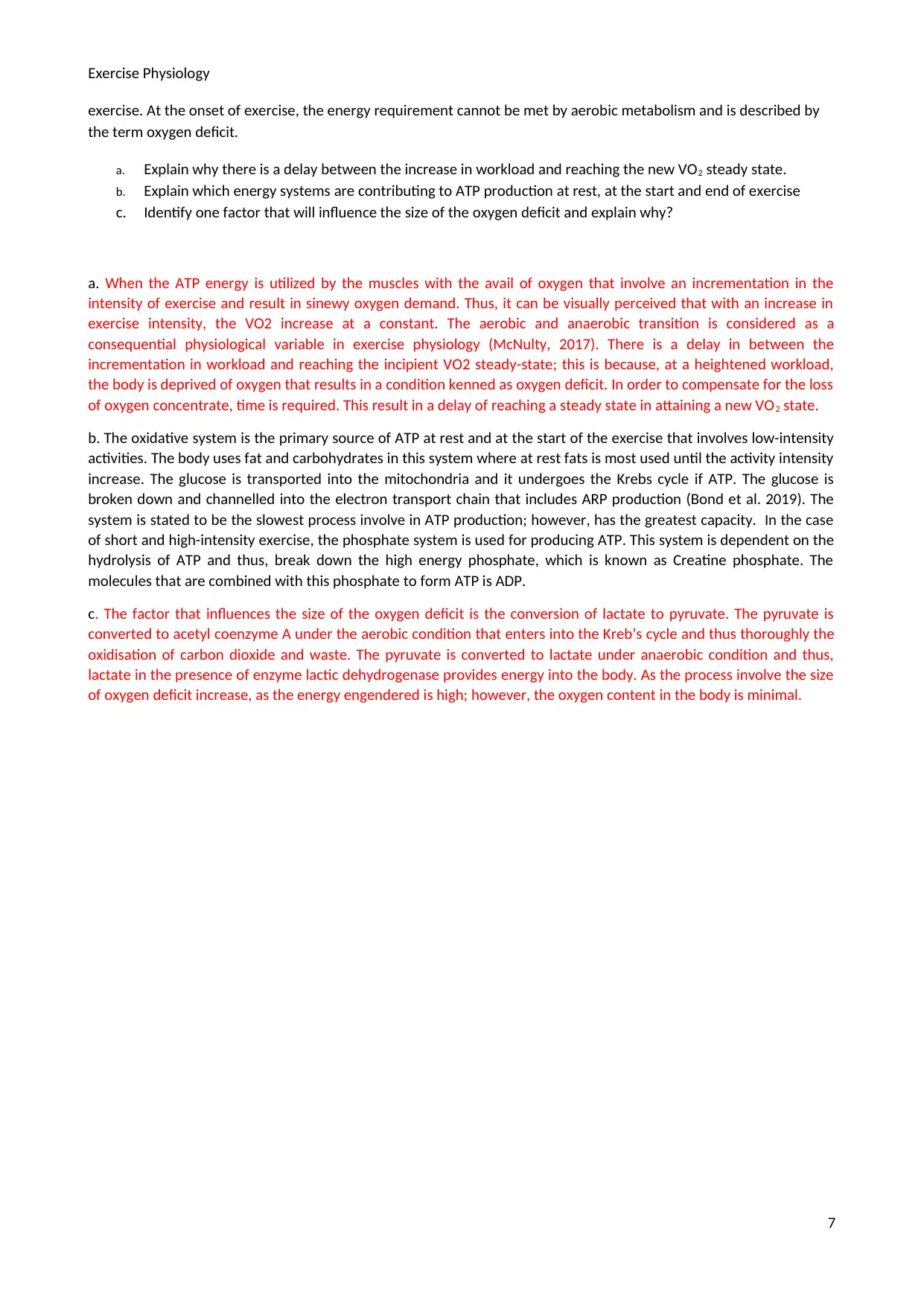
Exercise Physiology
exercise. At the onset of exercise, the energy requirement cannot be met by aerobic metabolism and is described by
the term oxygen deficit.
a. Explain why there is a delay between the increase in workload and reaching the new VO2 steady state.
b. Explain which energy systems are contributing to ATP production at rest, at the start and end of exercise
c. Identify one factor that will influence the size of the oxygen deficit and explain why?
a. When the ATP energy is utilized by the muscles with the avail of oxygen that involve an incrementation in the
intensity of exercise and result in sinewy oxygen demand. Thus, it can be visually perceived that with an increase in
exercise intensity, the VO2 increase at a constant. The aerobic and anaerobic transition is considered as a
consequential physiological variable in exercise physiology (McNulty, 2017). There is a delay in between the
incrementation in workload and reaching the incipient VO2 steady-state; this is because, at a heightened workload,
the body is deprived of oxygen that results in a condition kenned as oxygen deficit. In order to compensate for the loss
of oxygen concentrate, time is required. This result in a delay of reaching a steady state in attaining a new VO2 state.
b. The oxidative system is the primary source of ATP at rest and at the start of the exercise that involves low-intensity
activities. The body uses fat and carbohydrates in this system where at rest fats is most used until the activity intensity
increase. The glucose is transported into the mitochondria and it undergoes the Krebs cycle if ATP. The glucose is
broken down and channelled into the electron transport chain that includes ARP production (Bond et al. 2019). The
system is stated to be the slowest process involve in ATP production; however, has the greatest capacity. In the case
of short and high-intensity exercise, the phosphate system is used for producing ATP. This system is dependent on the
hydrolysis of ATP and thus, break down the high energy phosphate, which is known as Creatine phosphate. The
molecules that are combined with this phosphate to form ATP is ADP.
c. The factor that influences the size of the oxygen deficit is the conversion of lactate to pyruvate. The pyruvate is
converted to acetyl coenzyme A under the aerobic condition that enters into the Kreb’s cycle and thus thoroughly the
oxidisation of carbon dioxide and waste. The pyruvate is converted to lactate under anaerobic condition and thus,
lactate in the presence of enzyme lactic dehydrogenase provides energy into the body. As the process involve the size
of oxygen deficit increase, as the energy engendered is high; however, the oxygen content in the body is minimal.
7
exercise. At the onset of exercise, the energy requirement cannot be met by aerobic metabolism and is described by
the term oxygen deficit.
a. Explain why there is a delay between the increase in workload and reaching the new VO2 steady state.
b. Explain which energy systems are contributing to ATP production at rest, at the start and end of exercise
c. Identify one factor that will influence the size of the oxygen deficit and explain why?
a. When the ATP energy is utilized by the muscles with the avail of oxygen that involve an incrementation in the
intensity of exercise and result in sinewy oxygen demand. Thus, it can be visually perceived that with an increase in
exercise intensity, the VO2 increase at a constant. The aerobic and anaerobic transition is considered as a
consequential physiological variable in exercise physiology (McNulty, 2017). There is a delay in between the
incrementation in workload and reaching the incipient VO2 steady-state; this is because, at a heightened workload,
the body is deprived of oxygen that results in a condition kenned as oxygen deficit. In order to compensate for the loss
of oxygen concentrate, time is required. This result in a delay of reaching a steady state in attaining a new VO2 state.
b. The oxidative system is the primary source of ATP at rest and at the start of the exercise that involves low-intensity
activities. The body uses fat and carbohydrates in this system where at rest fats is most used until the activity intensity
increase. The glucose is transported into the mitochondria and it undergoes the Krebs cycle if ATP. The glucose is
broken down and channelled into the electron transport chain that includes ARP production (Bond et al. 2019). The
system is stated to be the slowest process involve in ATP production; however, has the greatest capacity. In the case
of short and high-intensity exercise, the phosphate system is used for producing ATP. This system is dependent on the
hydrolysis of ATP and thus, break down the high energy phosphate, which is known as Creatine phosphate. The
molecules that are combined with this phosphate to form ATP is ADP.
c. The factor that influences the size of the oxygen deficit is the conversion of lactate to pyruvate. The pyruvate is
converted to acetyl coenzyme A under the aerobic condition that enters into the Kreb’s cycle and thus thoroughly the
oxidisation of carbon dioxide and waste. The pyruvate is converted to lactate under anaerobic condition and thus,
lactate in the presence of enzyme lactic dehydrogenase provides energy into the body. As the process involve the size
of oxygen deficit increase, as the energy engendered is high; however, the oxygen content in the body is minimal.
7
Paraphrase This Document
Need a fresh take? Get an instant paraphrase of this document with our AI Paraphraser
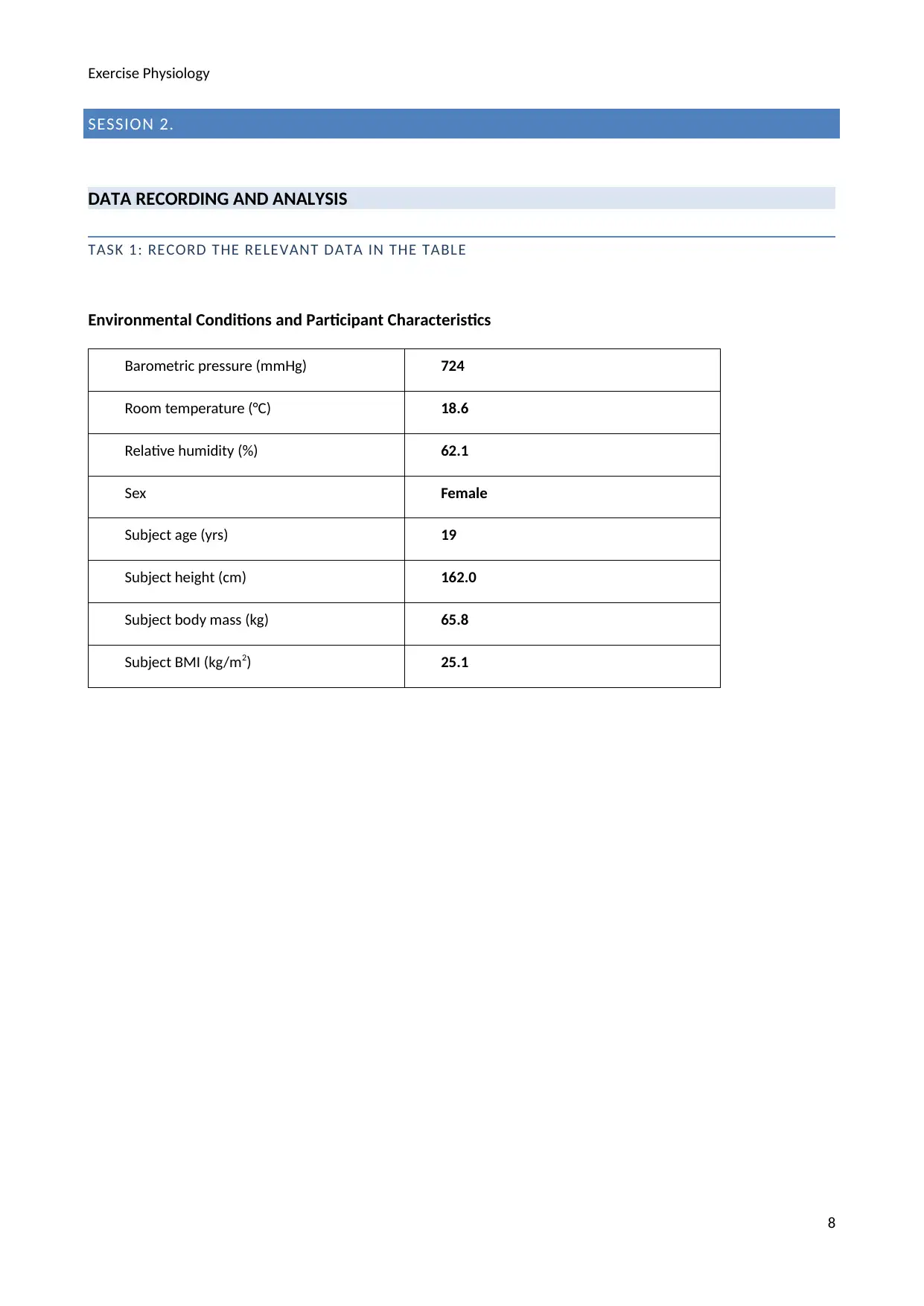
Exercise Physiology
SESSION 2.
DATA RECORDING AND ANALYSIS
TASK 1: RECORD THE RELEVANT DATA IN THE TABLE
Environmental Conditions and Participant Characteristics
Barometric pressure (mmHg) 724
Room temperature (°C) 18.6
Relative humidity (%) 62.1
Sex Female
Subject age (yrs) 19
Subject height (cm) 162.0
Subject body mass (kg) 65.8
Subject BMI (kg/m2) 25.1
8
SESSION 2.
DATA RECORDING AND ANALYSIS
TASK 1: RECORD THE RELEVANT DATA IN THE TABLE
Environmental Conditions and Participant Characteristics
Barometric pressure (mmHg) 724
Room temperature (°C) 18.6
Relative humidity (%) 62.1
Sex Female
Subject age (yrs) 19
Subject height (cm) 162.0
Subject body mass (kg) 65.8
Subject BMI (kg/m2) 25.1
8
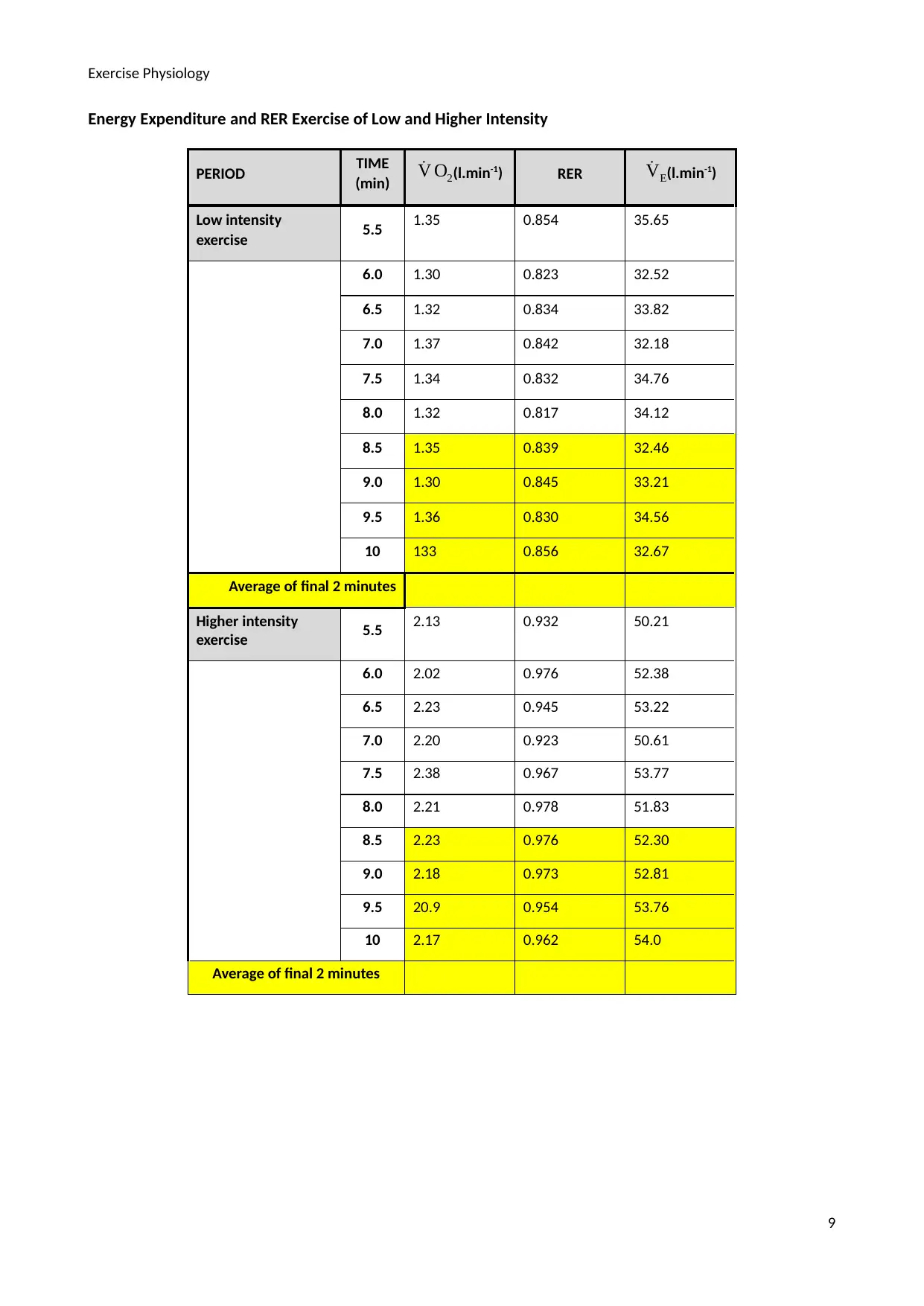
Exercise Physiology
Energy Expenditure and RER Exercise of Low and Higher Intensity
PERIOD TIME
(min) ˙V O2(l.min-1) RER ˙VE(l.min-1)
Low intensity
exercise 5.5 1.35 0.854 35.65
6.0 1.30 0.823 32.52
6.5 1.32 0.834 33.82
7.0 1.37 0.842 32.18
7.5 1.34 0.832 34.76
8.0 1.32 0.817 34.12
8.5 1.35 0.839 32.46
9.0 1.30 0.845 33.21
9.5 1.36 0.830 34.56
10 133 0.856 32.67
Average of final 2 minutes
Higher intensity
exercise 5.5 2.13 0.932 50.21
6.0 2.02 0.976 52.38
6.5 2.23 0.945 53.22
7.0 2.20 0.923 50.61
7.5 2.38 0.967 53.77
8.0 2.21 0.978 51.83
8.5 2.23 0.976 52.30
9.0 2.18 0.973 52.81
9.5 20.9 0.954 53.76
10 2.17 0.962 54.0
Average of final 2 minutes
9
Energy Expenditure and RER Exercise of Low and Higher Intensity
PERIOD TIME
(min) ˙V O2(l.min-1) RER ˙VE(l.min-1)
Low intensity
exercise 5.5 1.35 0.854 35.65
6.0 1.30 0.823 32.52
6.5 1.32 0.834 33.82
7.0 1.37 0.842 32.18
7.5 1.34 0.832 34.76
8.0 1.32 0.817 34.12
8.5 1.35 0.839 32.46
9.0 1.30 0.845 33.21
9.5 1.36 0.830 34.56
10 133 0.856 32.67
Average of final 2 minutes
Higher intensity
exercise 5.5 2.13 0.932 50.21
6.0 2.02 0.976 52.38
6.5 2.23 0.945 53.22
7.0 2.20 0.923 50.61
7.5 2.38 0.967 53.77
8.0 2.21 0.978 51.83
8.5 2.23 0.976 52.30
9.0 2.18 0.973 52.81
9.5 20.9 0.954 53.76
10 2.17 0.962 54.0
Average of final 2 minutes
9
⊘ This is a preview!⊘
Do you want full access?
Subscribe today to unlock all pages.

Trusted by 1+ million students worldwide
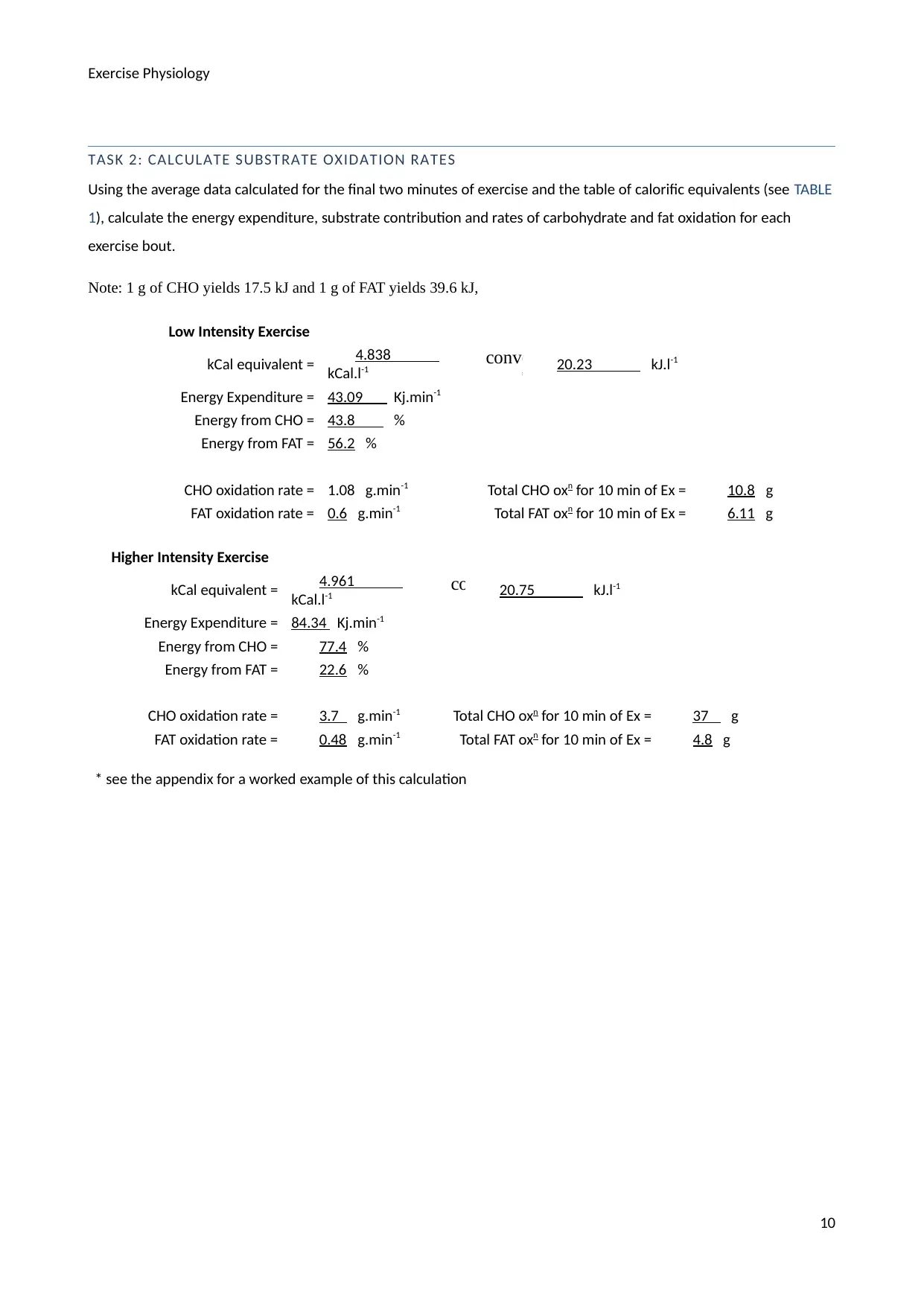
Exercise Physiology
TASK 2: CALCULATE SUBSTRATE OXIDATION RATES
Using the average data calculated for the final two minutes of exercise and the table of calorific equivalents (see TABLE
1), calculate the energy expenditure, substrate contribution and rates of carbohydrate and fat oxidation for each
exercise bout.
Note: 1 g of CHO yields 17.5 kJ and 1 g of FAT yields 39.6 kJ,
Low Intensity Exercise
kCal equivalent = 4.838
kCal.l-1
converts to
⇒ 20.23 kJ.l-1
Energy Expenditure = 43.09 Kj.min-1
Energy from CHO = 43.8 %
Energy from FAT = 56.2 %
CHO oxidation rate = 1.08 g.min-1 Total CHO oxn for 10 min of Ex = 10.8 g
FAT oxidation rate = 0.6 g.min-1 Total FAT oxn for 10 min of Ex = 6.11 g
Higher Intensity Exercise
kCal equivalent = 4.961
kCal.l-1 converts to
⇒ 20.75 kJ.l-1
Energy Expenditure = 84.34 Kj.min-1
Energy from CHO = 77.4 %
Energy from FAT = 22.6 %
CHO oxidation rate = 3.7 g.min-1 Total CHO oxn for 10 min of Ex = 37 g
FAT oxidation rate = 0.48 g.min-1 Total FAT oxn for 10 min of Ex = 4.8 g
* see the appendix for a worked example of this calculation
10
TASK 2: CALCULATE SUBSTRATE OXIDATION RATES
Using the average data calculated for the final two minutes of exercise and the table of calorific equivalents (see TABLE
1), calculate the energy expenditure, substrate contribution and rates of carbohydrate and fat oxidation for each
exercise bout.
Note: 1 g of CHO yields 17.5 kJ and 1 g of FAT yields 39.6 kJ,
Low Intensity Exercise
kCal equivalent = 4.838
kCal.l-1
converts to
⇒ 20.23 kJ.l-1
Energy Expenditure = 43.09 Kj.min-1
Energy from CHO = 43.8 %
Energy from FAT = 56.2 %
CHO oxidation rate = 1.08 g.min-1 Total CHO oxn for 10 min of Ex = 10.8 g
FAT oxidation rate = 0.6 g.min-1 Total FAT oxn for 10 min of Ex = 6.11 g
Higher Intensity Exercise
kCal equivalent = 4.961
kCal.l-1 converts to
⇒ 20.75 kJ.l-1
Energy Expenditure = 84.34 Kj.min-1
Energy from CHO = 77.4 %
Energy from FAT = 22.6 %
CHO oxidation rate = 3.7 g.min-1 Total CHO oxn for 10 min of Ex = 37 g
FAT oxidation rate = 0.48 g.min-1 Total FAT oxn for 10 min of Ex = 4.8 g
* see the appendix for a worked example of this calculation
10
Paraphrase This Document
Need a fresh take? Get an instant paraphrase of this document with our AI Paraphraser

Exercise Physiology
DATA REPORTING
TASK 3: SUBSTRATE OXIDATION RATES
Draw a bar graph to show the contribution of carbohydrate and fat (as a % of total energy expenditure) during the 2
exercise bouts.
Figure 4: Graph stating the
contribution of
carbohydrate and fat during
two exercise bouts
From the graph, it can be
clearly seen that in case low-
intensity exercise, the
utilisation of carbohydrate
was more in comparison to
fat. The reason for this energy state is fat requires less energy to breakdown that easily help the athlete to conduct a
phase of low-intensity exercise for a long period of time. Moreover, fat offer less energy as compared to carbohydrate
and thus, it is being preferred in this scenario. However, in case of high intensity, the energy utilisation is more the
carbohydrate provides that. The carbohydrate is an important fuel in case of exercise and sports activities. The body
can store it in the muscle and liver in the form of glycogen and is used when by requiring more amount of energy in
less period of time.
11
Carbohydrate Fat
0
10
20
30
40
50
60
70
80
90
Low intensity exercise High intensity exercise
DATA REPORTING
TASK 3: SUBSTRATE OXIDATION RATES
Draw a bar graph to show the contribution of carbohydrate and fat (as a % of total energy expenditure) during the 2
exercise bouts.
Figure 4: Graph stating the
contribution of
carbohydrate and fat during
two exercise bouts
From the graph, it can be
clearly seen that in case low-
intensity exercise, the
utilisation of carbohydrate
was more in comparison to
fat. The reason for this energy state is fat requires less energy to breakdown that easily help the athlete to conduct a
phase of low-intensity exercise for a long period of time. Moreover, fat offer less energy as compared to carbohydrate
and thus, it is being preferred in this scenario. However, in case of high intensity, the energy utilisation is more the
carbohydrate provides that. The carbohydrate is an important fuel in case of exercise and sports activities. The body
can store it in the muscle and liver in the form of glycogen and is used when by requiring more amount of energy in
less period of time.
11
Carbohydrate Fat
0
10
20
30
40
50
60
70
80
90
Low intensity exercise High intensity exercise

Exercise Physiology
12
12
⊘ This is a preview!⊘
Do you want full access?
Subscribe today to unlock all pages.

Trusted by 1+ million students worldwide
1 out of 16
Your All-in-One AI-Powered Toolkit for Academic Success.
+13062052269
info@desklib.com
Available 24*7 on WhatsApp / Email
![[object Object]](/_next/static/media/star-bottom.7253800d.svg)
Unlock your academic potential
Copyright © 2020–2025 A2Z Services. All Rights Reserved. Developed and managed by ZUCOL.